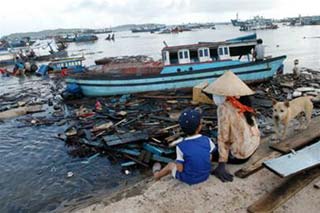Why consecutive storms occur?
When the consequences of Typhoon Durian in the Philippines and Vietnam have not been overcome, a new storm named Utor has formed in the South China Sea. Why do storms appear continuously, especially at the end of the hurricane season? Talking with Tuoi Tre , the meteorological and hydrological experts said.
* Sir, why did Mr. Durian just break away and appeared a new storm with strong intensity?
- Mr. NGUYEN VAN BUY (deputy director of short-term forecasting, Central Hydrometeorology Center): The temperature of the sea surface in the western Pacific Ocean is high this year, so the formation of the storm followed That storm is normal.
* But if this storm enters the East Sea, is it unusual for it to be the end of the hurricane season?
- Mr. Bay : This year's hurricane season in Vietnam is later than previous years. Usually there are five storms that appear early,

Typhoon Durian broke many ships in Phu Qui island (Binh Thuan) on December 5 (Photo: TTD)
there are late storms. This year, the storm season is later than many years, so there are still storms in December. Normally in May, June had to have storms but in May and June of this year there were no storms but more and more typhoons at the end of the season.
- Mr. VŨ ANH TUAN (head of short-term forecast department, Central Hydrometeorological Forecast Center): Utor storm into the East Sea is also a special storm because often in the last month of the year, there is little chance of a storm . Statistics from 1961 - 2005 had less than ten storms in December. Meanwhile, if including Utor storm, this year there have been two storms appeared in the last month of the year.
- Mr. LE DINH QUANG (former director of Center for Tropical Meteorology and Storm Research, Institute of Meteorology and Hydrology): The storms hit Vietnam formed from many factors. Now it is late in the storm season, so it is possible for storms to enter Vietnam, but the storm still works in the western Pacific region as normal because of the hot sea surface temperature in this area. However, one point that can be considered unusual is that this year, the storm in the western Pacific is not much, so far only about 22 attacks compared to the average of many years is 30-32 storms.
* Although storms in the Western Pacific region are many years less than average, but actually storms to the East Sea are many?
- Mr. Quang : If the typhoon directly affects Vietnam mainland area, 5-7 storms on average each year. Therefore, although this year storms into the East Sea, the number of storms that directly affect Vietnam is not much. The storms No. 1, 3, 4, 7, and 8 all turned to China or weakened into tropical depression before coming to the mainland.
* So how do you forecast the storm Utor?
- Mr. Quang : This season has cold air down so that when the storm moves into the East Sea, it affects the cold air, most of the storms are excited and move to the southwest. However, storms can enter the East Sea but from the East Sea to the mainland depends on the interaction of cold air and the intensity of the storm.
- Mr. Tuan : This year's storms are often strong storms and move from the Pacific Ocean. At the end of the storm season, due to the impact of cold air, sea surface temperature, the storms that appear at the end of the season have complicated paths.
K.HUNG performed
Five storms hit Vietnam in December from 1961-2005:
* Day 4-12-1972 : storm Therese (storm No. 10) strong level 10 landed in Binh Dinh area.
* December 2, 1993 : Level 10 hurricane Lola (storm No. 11) landed in Ninh Thuan area.
* December 9, 1998 : Hurricane Faith (storm No. 8) level 6 landed in Khanh Hoa area.
* December 14, 1999: Seventh-level storm No. 7 landed in Khanh Hoa area.
* December 5 , 2001: Typhoon Kajiki (storm No. 9) hit level 6 in Quang Tri.
- What is a storm? How storms form and why do storms occur?
- 3 consecutive storms hit Japan
- This year, there will be about 15 storms from
- The cleaner the air, the more the number of storms increases
- Safety skills when storms occur
- Snow and storms occur in some European countries
- Video: Fire storms make people impassive
- Three extremely rare tropical storms occur simultaneously on the Pacific Ocean
- Big storms appear in Central America and the Caribbean
- The most dangerous storms in Vietnam
- Things to know about solar storms
- Scary enemies of artificial satellites
 Green tea cleans teeth better than mouthwash?
Green tea cleans teeth better than mouthwash? Death kiss: This is why you should not let anyone kiss your baby's lips
Death kiss: This is why you should not let anyone kiss your baby's lips What is salmonellosis?
What is salmonellosis? Caution should be exercised when using aloe vera through eating and drinking
Caution should be exercised when using aloe vera through eating and drinking